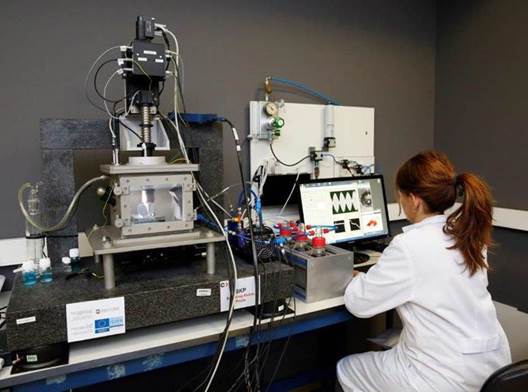Equipment/Techniques/Methodologies for the study and evaluation of corrosion

DESCRIPTION
There are well-equipped facilities that consist on:
- Climatic chambers to perform accelerated corrosion tests, controlling the temperature and humidity. Usually, an aggressive electrolyte is used (chloride based ones at different pH) with and without oxidizing agents (e.g. cupric ions).
- Electrochemical corrosion cells to expose a system of interest to an aggressive electrolyte (acidic, basic, chloride, fluoride, etc.). Different type of cells can be used: anti-crevice, temperature-control cell, horizontal flat cell, environment control cell, etc.
- Potentiostats with AC and DC to perform different electrochemical techniques to determine the resistance or the kinetic to be corroded in a specific media/electrolyte.
- Electrochemical working station for localized corrosion using a low conductivity electrolyte as aggressive environment for LEIS, SVET and ac/ic-SECM techniques.
- SKP for localized corrosion with or without the presence of an electrolyte
- Tribometer adapted with a corrosion cell to perform tribocorrosion tests.
MOST OUTSTANDING EQUIPMENT AND COMPONENTS
AC/DC-PotentiostatsAC/DC-Potentiostats to perform Pontentio/Galvano - static/dynamic perturbation as voltammetry, polarization curves, etc. and measurements at open circuit potential like electrochemical noise, impedance, etc. Several electrochemical cells with different features are available to be used.
Acquired during several years (most recent one 2017)
Climatic chambers for accelerated corrosion using chloride based solutions were either saturated humidity and/or aggressive environment based on chloride with and without: acidic pH, cupric ions.
Year of acquisition: 2018
Electrochemical working station for localized corrosion (LEIS, SVET, ac/ic-SECM) using a low conductivity electrolyte with a resolution in the micrometer range:
o LEIS is a scanning technique that combines information of the impedance at localised scale with time-constant resolved signals of conventional EIS to obtain impedance maps of the surface.
o SVET is a scanning technique measuring the potential gradients in the electrolyte (using a fine tipped vibrating microelectrode) due to the presence of anodic and cathodic areas on a surface (corrosion process).
o ac/ic-SECM is a scanned probe microscopy technique in which the electrochemical response of a mobile ultra-microelectrode (UME) tip is used to measure the electrochemical activity of the surface obtaining information like topography, specific elctrochemical reactions (recognizing active/passive regions).
Year of acquisition: 2015
SKP is a non-contact and nondestructive technique able to measure the work function difference between a sample and a reference probe using the vibration condenser method. It can be calibrated to obtain corrosion potential maps of the surface of conductive and semi-conductive materials. The topography can be obtained simultaneously.
Year of acquisition: 2015
Tribometer adapted with a corrosion cell to perform tribocorrosion tests in order to explore the degradation and synergy of wear and corrosion phenomena, simultaneously. Year of acquisition: 2015
SERVICES OFFERED BY THE ASSET

Climatic chambers for accelerated corrosion tests (neutral salt spray (NSS), cupric-acetic salt spray (CASS)). Conventional and localized electrochemical techniques for corrosion evaluation.
ENTITY MANAGING THE ASSET

CIDETEC
Contact person: Patricia López Ruiz


